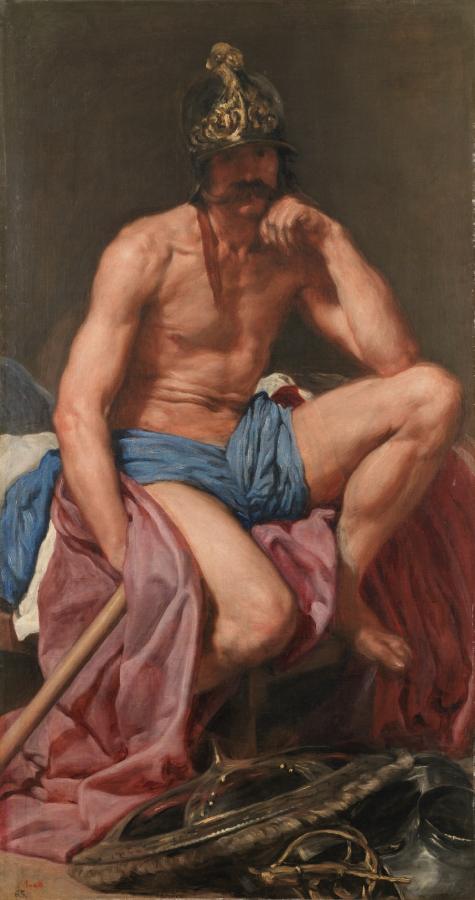Velázquez, Diego (1599-1660)
El dios Marte (Mars, God of War)
c.1638
Oil on canvas, 179 x 95 cm
Museo del Prado, Madrid
The first documentation of Diego Velazquez‘s Mars is from 1701–03, when it appeared in the inventory of paintings at the Torre de la Parada, the royal hunting pavilion on the outskirts of Madrid. The painting is cited along with Velázquez‘s Aesop c.1638 (P01206) and Menippus 1639–40 (P01207). The three paintings have similar dimensions, and each are as tall as the Heraclitus, Democritus and other images based on mythology and Greco-Roman literature that Peter Paul Rubens executed in 1636–38 as decorations for the pavilion. Any attempt at interpreting the origin and meaning of the present painting must take into account that context. As is habitual in Velázquez‘s oeuvre, in Mars there is a paradoxical treatment of the mythological subject matter, for which, in this case, the arms and other military attributes play a fundamental role. On the one hand, these elements allow us to identify the character as the Roman god of war, yet, on the other, the manner in which these elements are displayed situates the image in an ambiguous terrain. Of the various pieces of armour, the god only wears his helmet, and, rather than brandishing his general´s staff, he supports it indolently against the floor. His shield, sword and the rest of his armour lie at the feet of a soft, unmade bed on which the god himself is seated, resting in a lazy pose, and wearing a melancholy expression. The references to arms and martial objects, which are scattered about or piled on the floor, enjoyed a long tradition in both figurative arts and literature, and this painting clearly evokes that convention. Typically, the motif refers to the defeat of arms and, often, to the concept that love conquers all, a theme that was expressed frequently in emblemata and strikingly portrayed in the well-known painting by Caravaggio Amor vincit omnia 1601–02 (Gemäldegalerie, Berlin). The bedclothes, with their richly coloured sheets, do not belong to a soldier’s cot but, rather, to a luxurious bed much more suited to amorous struggle than for restoring the fighter’s strength after combat on the battlefield. In that contrast between what we would typically expect of Mars and his relaxed, melancholic state in this image, is where we are most likely to discover the painting’s meaning. In Mars, the tension between reality and story is also established by the formal construction of the image. Much has been made of this painting’s relationship with two splendid sculptures that were very familiar to artists in the seventeenth century: the so-called Ludovisi Ares (a Roman copy of a Greek original, which once belonged to the Ludovisi collection and is now in the Palazzo Altemps, Rome) and one of Michelangelo‘s sculptures for the Medici chapel in the Church of San Lorenzo, Florence, known as Il pensieroso (The Thinker). However, Velázquez‘s painting betrays a clear desire to represent living flesh with blood coursing through its veins, rather than to imitate sculpted stone. Thus, the painter has constructed his figure fundamentally on the basis of colour rather than line, with free and generous brushwork producing wonderfully diffuse outlines. The figure is animated by the very instability that its intentionally imprecise contours provide. That sensation of liveliness and verisimilitude is reinforced by the expression on the god´s face. Though we do not know whether the image is based on a live model, what is certain is that the painting reveals the artist’s expertise in visually describing human anatomy, and an explicit interest in making it clear to the viewer that he has attempted to explore his subject not with artistic tradition as his point of departure but, rather, starting from his own personal observations. (Portrait of Spain. Masterpieces from The Prado, Queensland Art Gallery, 2012, p.266-267, nº 101)
